We can parse this test XML file with this XSL file fine:
Test XML:
<?xml version="1.0" encoding="UTF-8"?>
<?xml-stylesheet href="newrows.xsl" type="text/xsl"?>
<Workbook>
<Worksheet>
<Table>
<Row>
<Cell></Cell>
<Cell>(info...)</Cell>
<Cell></Cell>
</Row>
<Row>
<Cell>first name</Cell>
<Cell>last name</Cell>
<Cell>age</Cell>
</Row>
<Row>
<Cell>Jim</Cell>
<Cell>Smith</Cell>
<Cell>34</Cell>
</Row>
<Row>
<Cell>Roy</Cell>
<Cell>Rogers</Cell>
<Cell>22</Cell>
</Row>
<Row>
<Cell>(info...)</Cell>
<Cell></Cell>
<Cell>(info...)</Cell>
</Row>
<Row>
<Cell>Sally</Cell>
<Cell>Cloud</Cell>
<Cell>26</Cell>
</Row>
<Row>
<Cell>John</Cell>
<Cell>Randall</Cell>
<Cell>44</Cell>
</Row>
</Table>
</Worksheet>
</Workbook>
XSL:
<?xml version="1.0" encoding="UTF-8"?>
<xsl:stylesheet xmlns:xsl="http://www.w3.org/1999/XSL/Transform" version="1.0">
<xsl:output method="xml" indent="yes"/>
<xsl:param name="range-1-begin" select="1"/>
<xsl:param name="range-1-end" select="3"/>
<xsl:param name="range-2-begin" select="5"/>
<xsl:param name="range-2-end" select="6"/>
<xsl:template match="Table">
<test>
<xsl:for-each select="Row">
<xsl:if test="(position() >= $range-1-begin and position() <= $range-1-end)
or (position() >= $range-2-begin and position() <= $range-2-end)">
<Row>
<xsl:for-each select="Cell">
<xsl:if test="position() = 1 or position() = 3">
<Cell>
<xsl:value-of select="."/>
</Cell>
</xsl:if>
</xsl:for-each>
</Row>
</xsl:if>
</xsl:for-each>
</test>
</xsl:template>
</xsl:stylesheet>
However, when we try to parse this similar XML file exported from Excel, it exports the content of every field with no XML element tags. We can even type in kksljflskdjf instead of Table and it outputs the content of every XML element.
What do I have to change in the XML/XSL file so that the XSL file correctly parses the XML?
Excel XML (exceprts):
<?xml version="1.0"?>
<?xml-stylesheet href="blackbox.xsl" type="text/xsl"?>
<Workbook
xmlns="urn:schemas-microsoft-com:office:spreadsheet" xmlns:o="urn:schemas-microsoft-com:office:office" xmlns:x="urn:schemas-microsoft-com:office:excel"
xmlns:ss="urn:schemas-microsoft-com:office:spreadsheet" xmlns:html="http://www.w3.org/TR/REC-html40">
<DocumentProperties xmlns="urn:schemas-microsoft-com:office:office">
<Author>MM</Author>
<LastAuthor>xx</LastAuthor>
...
<Worksheet ss:Name="OFFSET Individual">
<Names>
<NamedRange ss:Name="_FilterDatabase" ss:RefersTo="='OFFSET Individual'!R3C2:R3C12" ss:Hidden="1"/>
<NamedRange ss:Name="Print_Area" ss:RefersTo="='OFFSET Individual'!R4C2:R435C15"/>
<NamedRange ss:Name="Muster" ss:RefersTo="='OFFSET Individual'!C1:C9"/>
<NamedRange ss:Name="PAP" ss:RefersTo="='OFFSET Individual'!C2"/>
</Names>
<Table ss:ExpandedColumnCount="31" ss:ExpandedRowCount="443" x:FullColumns="1" x:FullRows="1" ss:StyleID="s90" ss:DefaultColumnWidth="59" ss:DefaultRowHeight="15">
<Column ss:StyleID="s416" ss:Hidden="1" ss:AutoFitWidth="0" ss:Width="61"/>
<Column ss:StyleID="s91" ss:AutoFitWidth="0" ss:Width="287"/>
<Column ss:StyleID="s547" ss:AutoFitWidth="0" ss:Width="216"/>
<Column ss:StyleID="s91" ss:AutoFitWidth="0" ss:Width="87"/>
<Column ss:StyleID="s92" ss:AutoFitWidth="0" ss:Width="202"/>
<Column ss:StyleID="s90" ss:AutoFitWidth="0" ss:Width="87"/>
<Column ss:StyleID="s101" ss:AutoFitWidth="0" ss:Width="284"/>
<Column ss:StyleID="s132" ss:Hidden="1" ss:AutoFitWidth="0" ss:Width="52"/>
<Column ss:StyleID="s137" ss:Hidden="1" ss:AutoFitWidth="0" ss:Width="47"/>
<Column ss:StyleID="s90" ss:Hidden="1" ss:AutoFitWidth="0" ss:Width="42"/>
<Column ss:StyleID="s90" ss:Hidden="1" ss:AutoFitWidth="0" ss:Width="39"/>
<Column ss:StyleID="s90" ss:Hidden="1" ss:AutoFitWidth="0" ss:Width="37"/>
<Column ss:StyleID="s113" ss:AutoFitWidth="0" ss:Width="47"/>
<Column ss:StyleID="s87" ss:Hidden="1" ss:AutoFitWidth="0" ss:Width="275"/>
<Column ss:StyleID="s458" ss:AutoFitWidth="0" ss:Width="89"/>
<Column ss:StyleID="s179" ss:AutoFitWidth="0" ss:Span="1"/>
<Column ss:Index="18" ss:StyleID="s168" ss:Hidden="1" ss:AutoFitWidth="0"/>
<Column ss:StyleID="s90" ss:Hidden="1" ss:AutoFitWidth="0"/>
<Column ss:StyleID="s377" ss:AutoFitWidth="0" ss:Width="202" ss:Span="2"/>
<Column ss:Index="23" ss:StyleID="s377" ss:AutoFitWidth="0" ss:Width="203"/>
<Row ss:AutoFitHeight="0" ss:Height="23">
<Cell ss:Index="2" ss:StyleID="s142">
<Data ss:Type="String">Paper Overview</Data>
<NamedCell ss:Name="PAP"/>
<NamedCell ss:Name="Muster"/>
</Cell>
</Row>
<Row ss:AutoFitHeight="0">
<Cell ss:Index="2" ss:StyleID="s141">
<Data ss:Type="String">Stand: 10.03.2011; 13:00 Uhr</Data>
<NamedCell ss:Name="PAP"/>
<NamedCell ss:Name="Muster"/>
</Cell>
</Row>
...
Here is an example of the resulting "XML" file:

Addendum
This is the full solution which now works, thanks @Dimitre!
<xsl:stylesheet version="1.0"
xmlns:xsl="http://www.w3.org/1999/XSL/Transform"
xmlns="urn:schemas-microsoft-com:office:spreadsheet"
xmlns:y="urn:schemas-microsoft-com:office:spreadsheet"
xmlns:o="urn:schemas-microsoft-com:office:office"
xmlns:x="urn:schemas-microsoft-com:office:excel"
xmlns:ss="urn:schemas-microsoft-com:office:spreadsheet"
xmlns:html="http://www.w3.org/TR/REC-html40"
exclude-result-prefixes="y o x ss html"
>
<xsl:strip-space elements="*"/>
<xsl:output method="xml" indent="yes"/>
<xsl:param name="range-1-begin" select="1"/>
<xsl:param name="range-1-end" select="3"/>
<xsl:param name="range-2-begin" select="5"/>
<xsl:param name="range-2-end" select="6"/>
<xsl:template match="text()"/>
<xsl:template match="y:Table">
<test>
<xsl:for-each select="y:Row">
<xsl:if test="(position() >= $range-1-begin and position() <= $range-1-end)
or (position() >= $range-2-begin and position() <= $range-2-end)">
<Row>
<xsl:for-each select="y:Cell">
<xsl:if test="position() = 1 or position() = 3">
<Cell>
<xsl:value-of select="."/>
</Cell>
</xsl:if>
</xsl:for-each>
</Row>
</xsl:if>
</xsl:for-each>
</test>
</xsl:template>
</xsl:stylesheet>